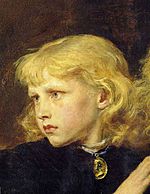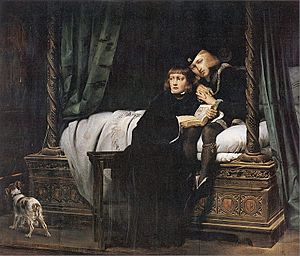Richard of Shrewsbury, Duke of York facts for kids
Quick facts for kids Richard of Shrewsbury |
|
|---|---|
| Duke of York; Duke of Norfolk; Earl of Nottingham | |

Richard as imagined in 1878
|
|
| Born | 17 August 1473 Shrewsbury, Shropshire, England |
| Died | c. mid-1483 (aged 9–10) Tower of London? |
| Burial | Unknown |
| Spouse | |
| House | York |
| Father | Edward IV |
| Mother | Elizabeth Woodville |
Richard of Shrewsbury, Duke of York (born August 17, 1473), was a prince of England. He was the sixth child and second son of King Edward IV and Elizabeth Woodville. Richard was born in Shrewsbury.
Richard and his older brother, King Edward V, are famous for a mystery. They both disappeared in 1483. This happened shortly after their uncle, Richard III, became king. Their disappearance is one of the biggest unsolved mysteries in English history.
Contents
Royal Titles and Marriage
Prince Richard received many important titles when he was very young. In May 1474, he was made Duke of York. The next year, he became a Knight of the Garter. From that time on, it became a tradition for the second son of the English king to be called the Duke of York.
Richard also became the Earl of Nottingham in June 1476. When he was only four years old, on January 15, 1478, he married Anne de Mowbray, 8th Countess of Norfolk. Anne was five years old and had inherited a lot of land and wealth. Their wedding took place in St Stephen's Chapel in Westminster.
Because Anne's father had no male heirs, his title of Duke of Norfolk ended. To keep the title in the family, Richard was made Duke of Norfolk and Earl Warenne in February 1477. Sadly, Anne de Mowbray died in November 1481. Her large estates should have gone to other relatives.
However, in January 1483, a special law was passed by Parliament. This law gave Anne's lands to Richard, Duke of York and Norfolk, for his whole life. This meant the other relatives who should have inherited the land did not get it.
Becoming Heir to the Throne

Richard's father, King Edward IV, died on April 9, 1483. After his father's death, Richard's older brother, Edward, became the new King of England. This made Richard the Heir Presumptive, meaning he was next in line to the throne if his brother had no children.
But this situation did not last long. A priest claimed that King Edward IV had promised to marry another woman before he married Richard's mother, Elizabeth Woodville. This would have made Edward's marriage to Elizabeth invalid. If their marriage was not valid, then all their children, including Edward V and Richard, would not be considered legitimate heirs to the throne.
Because of this claim, a group of powerful people, led by Richard's uncle Richard, Duke of Gloucester, declared that Edward V and Richard were not rightful heirs. On June 25, 1483, they were removed from the line of succession. Since Richard, Duke of Gloucester, was the only other surviving brother of Edward IV, he became King Richard III.
The Mystery of the Princes in the Tower

After his uncle became king, Richard, Duke of York, was sent to the Tower of London. The Tower was a royal residence at the time. He was held there with his brother, Edward V. People sometimes saw them playing in the Tower garden. However, there are no known sightings of them after the summer of 1483.
What happened to the two brothers, known as the Princes in the Tower, after they disappeared is still a mystery. Many people at the time, and later historians, blamed their uncle, King Richard III.
One famous writer, Thomas More, wrote that the princes were smothered to death with their pillows. His story was used by William Shakespeare in his play Richard III. In the play, King Richard orders the princes to be killed. However, some historians have questioned if Richard III was truly guilty.
Some historians think that Edward V might have died from an illness. Before the boys disappeared, Edward was often visited by a doctor. This led some people to believe he might have died naturally or from attempts to cure him.
Since there is no clear proof, many other ideas have been suggested. Some believe they were murdered by the Duke of Buckingham or by Henry Tudor (who later became King Henry VII).
In 1674, workers rebuilding a staircase in the Tower found bones believed to belong to two children. King Charles II ordered these bones to be placed in Westminster Abbey. They were put in an urn with the names of Edward and Richard on it.
The bones were looked at again in 1933. It was found that the skeletons were not complete and had animal bones mixed in. So, it has never been proven that these bones truly belonged to the princes.
In 1789, workers at St George's Chapel in Windsor found a vault. Inside were two children's coffins. This tomb was thought to contain two of Edward IV's other children who had died young. However, the remains of those children were later found elsewhere in the chapel. This means the children in the coffins within that tomb are still unknown.
In 1486, Richard of Shrewsbury's oldest sister, Elizabeth, married Henry Tudor. This marriage helped to unite the two powerful families, the Houses of York and Lancaster, and brought an end to the Wars of the Roses.
The Perkin Warbeck Claim
In 1491, a young man named Perkin Warbeck appeared in Cork, Ireland. He was from Flanders and claimed to be Richard, Duke of York. He said he had escaped from the Tower of London and had been hiding for years.
For the next six years, Warbeck traveled across Europe. Some kings, like Maximilian I, Holy Roman Emperor and James IV of Scotland, even recognized him as "Richard IV" of England. Richard's own aunt, Margaret of York, also supported Warbeck's claim.
After a failed attempt to invade England in 1497, Warbeck was captured. He was held in the Tower of London. He eventually admitted that he was not the real Richard. He was later executed after trying to escape.
Coat of Arms
As a son of the king, Richard was allowed to use the royal coat of arms of England. To show he was a prince, his arms had a special white stripe with a red square on it.
See also
- List of people who disappeared


